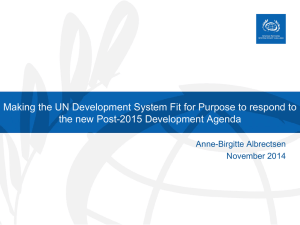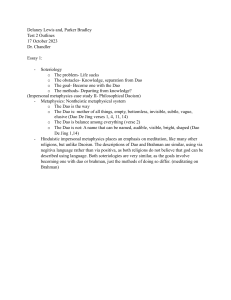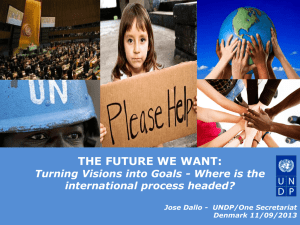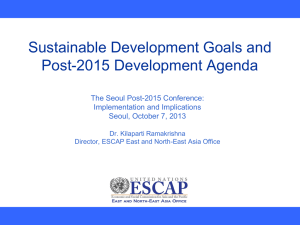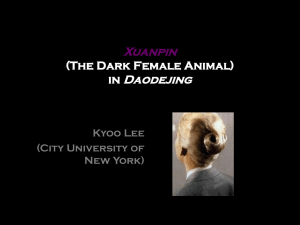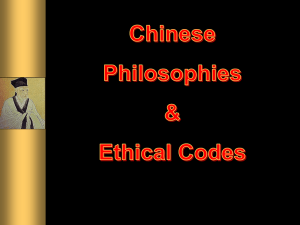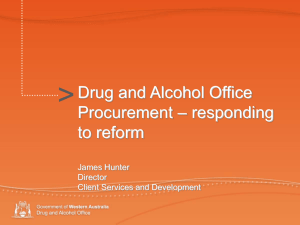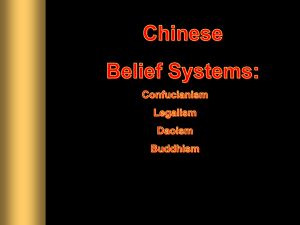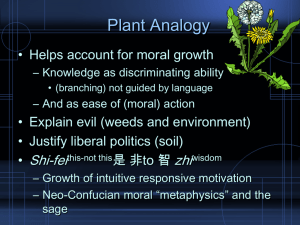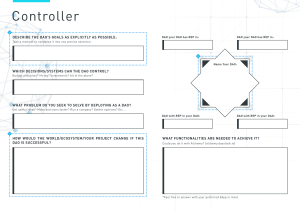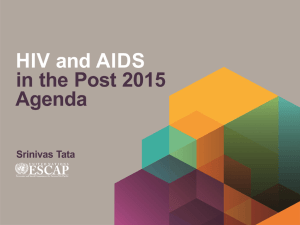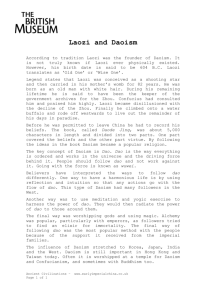Within the UN System
advertisement
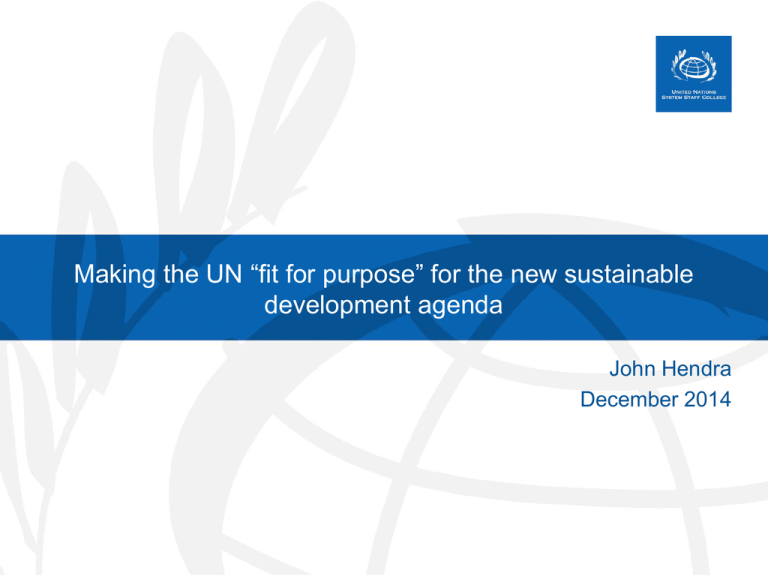
Making the UN “fit for purpose” for the new sustainable development agenda John Hendra December 2014 Post-2015 Development Agenda Vertical MDGs Siloed North-South SDGs Horizontal Integrated Universal SDGs as a Transformative Agenda SDGs are much more of a transformative agenda than Rights-based MDGs perspective: focus on inequality and discrimination Climate change and development agenda in one SDGS Inclusion of Governance, Rule of law, and Peace and Security Getting to Zero and Leaving No One Behind Road to Dignity by 2030: Fit for Purpose A UN that is “fit for purpose” is one that is: • Relevant • Innovative • Agile • Inclusive • Coordinated • Results-oriented • Guided by universal human rights and international norms • Integrates UN normative frameworks with operational activities • Responsive to differentiated needs of countries Road to Dignity by 2030: Fit for Purpose UN Fit for Purpose Specialized advice Shared goals Integrated approach Various Forge disciplines with relevant Partnerships skills sets Visionary and committed leadership Global, highly skilled and adaptable international civil service Current discussion on “Fit for Purpose” Among Member States: final intergovernmental post-2015 negotiations, ECOSOC’s dialogues on “Future Positioning of the UN Development System ” (first dialogue on 15 December 2014) 3 Levels of Discussion In countries: adopting Delivering as One Within the UN System: CEB and its pillars – UNDG, HLCM, HLCP (joint retreat of HLCP/HLCM; also retreat of UNDG, all held in November 2014). Delivering as One (DaO) 2.0 Increasing number of governments and country teams adopting the second generation of Delivering as One Of respondents said DaO made it “much or somewhat easier” to engage with the UN System Of governments are interested in implementing some or all of the elements of DaO Source: UN DESA Survey on QCPR UN Synthesis Report UN Country Teams will provide coherent support to national stakeholders while accelerating implementation of the SOPs for DaO for sustainable development to achieve greater results Delivering as One (DaO) 2.0 What is DaO 2.0? Moving from process to results Operationalizing the “spirit” of working together in a very practical and results-oriented way Draws on all the experience and lessons learned from the pilots, incorporates key pillars of the original DaO: One Leader, One Programme, One Budgetary Framework, Operating as One plus Communicating as One. Strategic positioning, relevance, results and operational efficiencies Delivering as One (DaO) 2.0 What we need: Take an integrated approach in the roll-out of the SOPs Take a coherent approach to their adoption Headquarters to speed up efforts to implement the UNDG Plan of Action for HQs. Six additional critical areas Integrated policy support at all levels Drive forward and help implement data revolution Ensure much greater transparency These are areas for immediate to mediumterm action Open up the UN to be more consultative Better pooling of resources Take more systemic, system-wide approach to assessing risk and promoting resilience Six additional critical areas Integrated policy support at all levels • Draw on expertise of different agencies • Example: UN’s Technical Support Team (TST) supporting SDG Open Working Group Drive forward and help implement data revolution • Ensure that data and evidence are used more effectively, systematically, and transparently • Disaggregation of data • Provide more integrated capacity development support to national statistical bodies • Real-time monitoring for rapid feedback on the impact of interventions Six additional critical areas Take more systemic, systemwide approach to assessing risk and promoting resilience • Encourage and promote more integrated partnerships and collaboration between humanitarian action and development • Build national and local capacity Better pooling of resources • Bring together development and humanitarian financing where it makes sense • Ensure negotiated, sustained and coherent financing for the long-term support to the post-2015 agenda Six additional critical areas Open up the UN to be more consultative Ensure much greater transparency • With civil society, private sector, parliamentarians and other stakeholders • Ensure greater multi-sector engagement in UN planning and monitoring, knowledge sharing and advocacy efforts in the design of new UN country frameworks • “Unbundle” current multi-stakeholder partnerships • Both financial and human resources at country, regional and global levels • Sharing data, analysis, programme and operations information. Structural Reform of the UN Development System Impetus will come from a clear political process led by Member States themselves ECOSOC dialogues on the “Future Positioning of the UN Development System” Final inter-governmental negotiations of the Post-2015 Development Agenda to include for the UN to be “fit for purpose” It will require our efforts, commitment and full engagement of staff at all levels Thank you.
